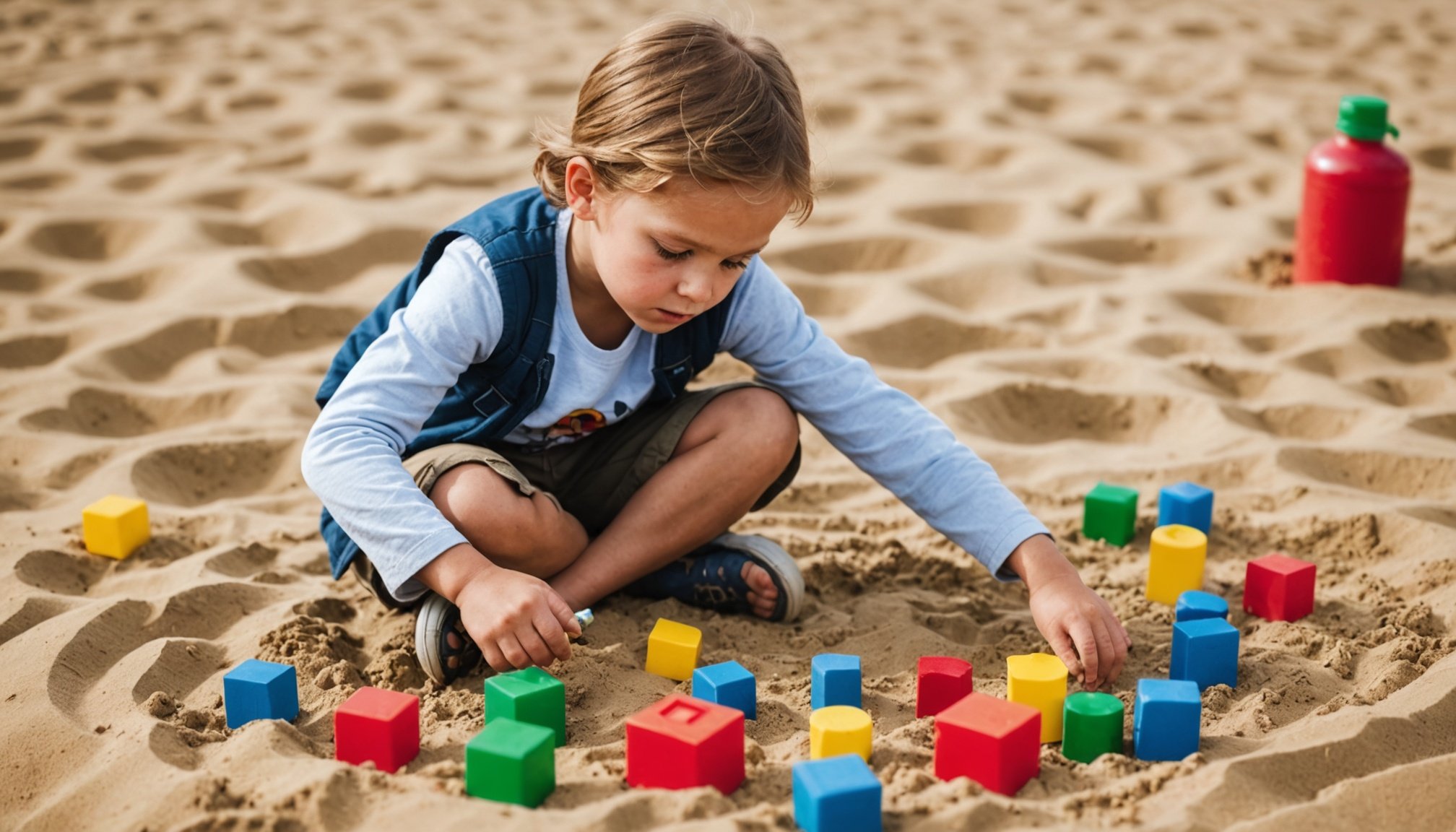Understanding Sandplay Therapy
Sandplay therapy is a unique form of psychoanalysis that enables self-expression through the use of sand and miniature figures. It was developed by Dora Kalff, inspired by the work of Swiss psychiatrist Carl Jung. This therapeutic approach is especially renowned in the context of childhood therapy, providing a nurturing environment where children can express their internal worlds without reliance on verbal communication.
At its core, sandplay therapy focuses on the methodology of creating a tangible scene within a sandbox, representing the child’s personal experiences and emotions. This allows therapists to gain insights into the child’s subconscious mind, observing themes and patterns in the scenes crafted during sessions.
Also to see : Natural vs. Synthetic Vitamins: How Do They Influence Your Health?
Several core principles underpin sandplay therapy’s efficacy. Foremost, it emphasises a non-verbal, creative process where the therapist takes an observer role, allowing the child’s process to unfold naturally. This neutrality fosters a safe space for self-discovery and emotional healing.
In terms of its importance in childhood therapeutic interventions, sandplay therapy is invaluable for children who struggle to articulate emotions. It facilitates emotional release and promotes psychological growth, making it a vital tool in addressing childhood emotional and behavioural challenges. As a non-invasive and child-centered approach, sandplay therapy continues to gain recognition and application in therapeutic settings globally.
Also to read : Can Plant-Based Diets Significantly Lower Your Risk of Type 2 Diabetes?
The Role of Anxiety Disorders in Children
Childhood anxiety disorders are surprisingly common and can significantly impact a child’s development and well-being. Such disorders manifest in various forms, including Generalised Anxiety Disorder (GAD), Separation Anxiety Disorder, and Social Anxiety Disorder. Each of these conditions presents unique challenges and requires tailored approaches from caregivers and therapists.
The impact of anxiety on child development can be profound. Children suffering from anxiety may experience difficulties in academic performance, social interactions, and self-esteem. This condition can also lead to physical symptoms such as headaches, stomachaches, and sleep disturbances. It’s crucial for parents and educators to be aware of these potential effects and seek appropriate interventions.
Prevalence rates of anxiety disorders in youth highlight the importance of attention and care. Studies indicate that about 7.1% of children aged 3-17 have been diagnosed with an anxiety disorder, making it one of the most common mental health challenges in children. Addressing these issues early can help mitigate long-term consequences and improve overall life quality for affected children. Prioritising awareness and understanding of childhood anxiety disorders enables more effective support and intervention strategies.
Evidence of Effectiveness of Sandplay Therapy
Sandplay therapy’s effectiveness has been supported by various research studies, which consistently highlight its therapeutic outcomes. Studies have demonstrated that this form of therapy aids in psychological healing, particularly in children experiencing anxiety. By creating controlled, imaginative scenes, children explore and express complex emotions, leading to reduced symptoms and improved emotional well-being.
In measuring success rates, research reflects positive changes in anxiety levels and emotional expression through sandplay therapy. Children participating in these sessions often exhibit increased coping mechanisms and better social interactions post-therapy. These outcomes underscore sandplay’s potential as a valuable therapeutic tool.
Comparisons with alternative therapies reveal that sandplay uniquely addresses anxiety by leveraging creative expression sans verbal communication. This distinctive approach sets it apart from talk-based therapies, potentially making it more effective for certain individuals, particularly young children who find it challenging to articulate their feelings.
While traditional therapy approaches focus on dialogue, sandplay therapy provides an engaging medium that fosters interaction with therapeutic elements. Such methodologies highlight its specific advantage in treating childhood anxiety, reinforcing its role as a crucial intervention in mental health strategies.
Case Studies: Sandplay Therapy in Action
In the realm of sandplay therapy, case studies provide crucial insights into its practical applications and outcomes. These real-world applications showcase how the therapy translates into tangible benefits for individuals, particularly children. Each session invites participants to build scenes using sand and miniatures, helping therapists decode underlying emotional landscapes.
One notable case involved a young boy struggling with social anxiety. Through sequential therapy sessions, he depicted overwhelming and chaotic sand scenes gradually evolving into ordered and calm environments. This transformation illustrated reduced anxiety levels and improved emotional regulation, marking a successful therapeutic journey.
While the therapy paves way for constructive outcomes, individual differences can influence results. Practitioner insights reveal that therapy examples often highlight varied symptoms aligning with unique personalities and circumstances. Some may progress swiftly, while others require prolonged engagement.
Practitioners assert that flexibility is key in navigating these differences, tailoring each session to the child’s specific needs. Acknowledging that case study results vary, experts highlight the therapy’s overarching principle: facilitating a non-verbal creative expression. This method ultimately promotes healing and reflects the diverse potential of sandplay therapy in addressing emotional challenges.
Expert Opinions on Sandplay Therapy
While the benefits of sandplay therapy are well-documented, insights from therapy professionals provide a deeper understanding of its value. These experts highlight sandplay’s unique approach, which allows children to communicate thoughts and emotions without verbal barriers. According to seasoned practitioners, this nonverbal method proves invaluable for individuals, particularly children, who may find it difficult to articulate feelings verbally.
One prominent voice in the field, Dr. Mary Watkins, an established figure in child psychology, describes sandplay therapy as an “invaluable tool,” offering children a safe space for exploration. Her perspective aligns with the consensus that sandplay nurtures emotional growth and self-awareness. Additionally, Dr. Watkins emphasises the importance of maintaining a neutral, supportive environment to ensure therapeutic efficacy.
Other experts like Dr. John Allan advocate for creative expression through sandplay, noting that many children show remarkable transformation as they transition from chaos to calm within their sand scenes. This transformation is often a potent indicator of internal healing and balance.
Practitioners agree that best practices include thorough training for facilitators and consistent session structuring to maximise outcomes. They underscore the therapy’s adaptability, making it applicable across varied child development contexts.
Comparing Sandplay Therapy with Alternative Therapies
Sandplay therapy offers a distinctive non-verbal approach that contrasts with many alternative therapies designed for addressing childhood anxiety. One of the primary benefits of sandplay is its use of creative expression through tangible elements, which provides children an outlet that is less reliant on verbal interaction. In comparison, traditional cognitive-behavioural therapy (CBT) focuses on dialogue and changing thought patterns, making it more suited for children capable of verbal assessment and reassessment of emotions.
Other therapies, such as play therapy, engage children similarly through play but often require more interaction between the child and therapist. This can sometimes limit self-expression, unlike the open-ended creativity in sandplay, which encourages children to construct their own narratives without immediate interpretation or direction.
When deciding between treatment modalities, it’s crucial to consider the child’s comfort level with different forms of expression. If verbal communication is challenging, sandplay therapy can offer a more accessible medium for emotional healing. However, for older children or those able to articulate their feelings, combining therapies like CBT might enhance treatment efficacy. Tailoring therapy to individual needs ensures a more personalised and effective approach to managing anxiety.
Practical Considerations for Implementing Sandplay Therapy
Implementing sandplay therapy requires careful planning and an understanding of its framework. These sessions involve creating a conducive space where emotional exploration can naturally unfold, guided by specific practical applications.
Therapists must focus on the essentials, such as establishing a suitable setting for therapy sessions. This typically involves a sandbox, various miniature figures, and ensuring privacy to allow uninhibited self-expression. Creating a welcoming and neutral atmosphere is crucial, as it encourages safety and openness.
For effective implementation, therapists are advised to follow structured guidelines that promote optimal therapeutic outcomes. These strategies include allowing ample time for each session, adopting a non-directive approach, and maintaining a balance between observation and intervention.
The selection of appropriate resources and materials is vital, adding diversity and thematic representation to the available miniature figures. Such a variety can accommodate different emotional expressions and narratives. Materials should be easily accessible, organised, and replenished regularly.
Continual professional development and training bolster a therapist’s ability to facilitate sandplay therapy effectively. Comprehensive understanding of methodological principles allows therapists to tailor their approach, accommodating the unique needs of each child. Thus, preparing adequately for sessions enhances the potential for healing and positive change in the child’s emotional landscape.











